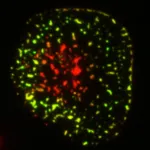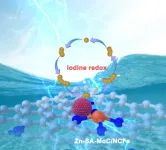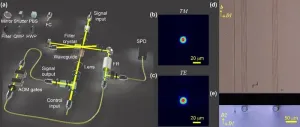(Press-News.org) Link to full release:
https://www.washington.edu/news/2025/01/03/galaxy-carbon-conveyer-belt/
FROM: James Urton
University of Washington
206-543-2580
jurton@uw.edu
(Note: researcher contact information at the end)
For immediate release
Friday, Jan. 3, 2025
The carbon in our bodies probably left the galaxy and came back on cosmic ‘conveyer belt’
Life on Earth could not exist without carbon. But carbon itself could not exist without stars. Nearly all elements except hydrogen and helium — including carbon, oxygen and iron — only exist because they were forged in stellar furnaces and later flung into the cosmos when their stars died. In an ultimate act of galactic recycling, planets like ours are formed by incorporating these star-built atoms into their makeup, be it the iron in Earth’s core, the oxygen in its atmosphere or the carbon in the bodies of Earthlings.
A team of scientists based in the U.S. and Canada recently confirmed that carbon and other star-formed atoms don’t just drift idly through space until they are dragooned for new uses. For galaxies like ours, which are still actively forming new stars, these atoms take a circuitous journey. They circle their galaxy of origin on giant currents that extend into intergalactic space. These currents — known as the circumgalactic medium — resemble giant conveyer belts that push material out and draw it back into the galactic interior, where gravity and other forces can assemble these raw materials into planets, moons, asteroids, comets and even new stars.
“Think of the circumgalactic medium as a giant train station: It is constantly pushing material out and pulling it back in,” said team member Samantha Garza, a University of Washington doctoral candidate. “The heavy elements that stars make get pushed out of their host galaxy and into the circumgalactic medium through their explosive supernovae deaths, where they can eventually get pulled back in and continue the cycle of star and planet formation.”
Garza is lead author on a paper describing these findings that was published Dec. 27 in the Astrophysical Journal Letters.
“The implications for galaxy evolution, and for the nature of the reservoir of carbon available to galaxies for forming new stars, are exciting,” said co-author Jessica Werk, UW professor and chair of the Department of Astronomy. “The same carbon in our bodies most likely spent a significant amount of time outside of the galaxy!”
In 2011, a team of scientists for the first time confirmed the long-held theory that star-forming galaxies like ours are surrounded by a circumgalactic medium — and that this large, circulating cloud of material includes hot gases enriched in oxygen. Garza, Werk and their colleagues have discovered that the circumgalactic medium of star-forming galaxies also circulates lower-temperature material like carbon.
“We can now confirm that the circumgalactic medium acts like a giant reservoir for both carbon and oxygen,” said Garza. “And, at least in star-forming galaxies, we suggest that this material then falls back onto the galaxy to continue the recycling process.”
Studying the circumgalactic medium could help scientists understand how this recycling process subsides, which will happen eventually for all galaxies — even ours. One theory is that a slowing or breakdown of the circumgalactic medium’s contribution to the recycling process may explain why a galaxy’s stellar populations decline over long periods of time.
“If you can keep the cycle going — pushing material out and pulling it back in — then theoretically you have enough fuel to keep star formation going,” said Garza.
For this study, the researchers used the Cosmic Origins Spectrograph on the Hubble Space Telescope. The spectrograph measured how light from nine distant quasars — ultra-bright sources of light in the cosmos — is affected by the circumgalactic medium of 11 star-forming galaxies. The Hubble readings indicated that some of the light from the quasars was being absorbed by a specific component in the circumgalactic medium: carbon, and lots of it. In some cases, they detected carbon extending out almost 400,000 light years — or four times the diameter of our own galaxy — into intergalactic space.
Future research is needed to quantify the full extent of the other elements that make up the circumgalactic medium and to further compare how their compositions differ between galaxies that are still making large amounts of stars and galaxies that have largely ceased star formation. Those answers could illuminate not just when galaxies like ours transition into stellar deserts, but why.
Co-authors on the paper are Trystyn Berg, research fellow at the Herzberg Astronomy and Astrophysics Research Centre in British Columbia; Yakov Faerman, a UW postdoctoral researcher in astronomy; Benjamin Oppenheimer, a research fellow at the University of Colorado Boulder; Rongmon Bordoloi, assistant professor of physics at North Carolina State University; and Sara Ellison, professor of physics and astronomy at the University of Victoria. The research was funded by NASA and the National Science Foundation.
###
For more information, contact Garza at samgarza@uw.edu and Werk at jwerk@uw.edu.
END
Since its discovery in the 1990s, “programmed cell death protein 1,” or PD-1, has been regarded as a leading target in cancer treatments. A “checkpoint” receptor that often resides on the surface of immune system cells, the PD-1 molecule works as a type of off switch that keeps immune cells from attacking other cells.
After its discovery, which revolutionized oncology and earned a 2018 Nobel Prize, researchers developed new drugs to block PD-1 and unleash the body’s immune system to fight cancer. Yet treatments leveraging PD-1 are only effective in a small fraction of cancer patients, highlighting ...
A NASA X-ray imager is heading to the Moon as part of NASA's Artemis campaign, where it will capture the first global images of the magnetic field that shields Earth from solar radiation.
The Lunar Environment Heliospheric X-ray Imager, or LEXI, instrument is one of 10 payloads aboard the next lunar delivery through NASA’s CLPS (Commercial Lunar Payload Services) initiative, set to launch from the agency's Kennedy Space Center in Florida no earlier than mid-January, with Firefly Aerospace’s Blue Ghost Lander. The instrument will support ...
Aqueous zinc-ion batteries (ZIBs) have attracted extensive attention due to their high safety, abundant reserves, and environmental friendliness. Iodine with high abundance in seawater (55 μg L−1) is highly promising to fabricate zinc-iodine batteries due to high theoretical capacity (211 mAh g−1) and appropriate redox potential (0.54 V). However, the low electrical conductivity of iodine hinders the redox conversion for the efficient energy storage process with zinc. Additionally, the formed soluble polyiodides are prone to migirate to Zn anode, leading to capacity degration and ...
The American Meteorological Society continuously publishes research on climate, weather, and water in its 12 journals. Many of these articles are available for early online access–they are peer-reviewed, but not yet in their final published form.
Below is a selection of articles published early online recently. Some articles are open-access; to view others, members of the media can contact kpflaumer@ametsoc.org for press login credentials.
JOURNAL ARTICLES
The Impact of Snowoff Timing and Associated Atmospheric Drivers on the Alaska Wildfire Season
Earth Interactions
Earlier ...
AURORA, Colo. (Jan. 3, 2025) – A first of its kind study, published today in Pediatrics, has provided full-picture assessment of youth homelessness in Denver, Colorado. The findings reveal that nearly 25% of youth in Denver experienced homelessness or housing insecurity in 2021, with rates increasing almost every year since 2017.
Researchers across Colorado, led by Josh Barocas, MD and resident Matthew Westfall, MD of the University of Colorado Anschutz Medical Campus, combined multiple data sources for youth aged 14 to 17 in the City of Denver, to estimate the total number ...
The synchronization function of quantum memories can be employed to connect multiple short-distance entanglement into long-distance entanglement, so that to effectively overcome the transmission loss of photons and enable the construction of large-scale quantum networks. The rare-earth ions doped crystals is a candidate system for implementation of quantum memories with excellent performances, and integrated solid-state quantum memories have been successfully demonstrated with various micro- and nano- fabrication techniques.
All previous demonstrations of integrated quantum memories for light are limited to the storage ...
University of Arizona researchers have revealed new insights into one of the most common complications faced by Parkinson's disease patients: uncontrollable movements that develop after years of treatment.
Parkinson's disease – a neurological disorder of the brain that affects a person's movement – develops when the level of dopamine, a chemical in the brain that's responsible for bodily movements, begins to dwindle. To counter the loss of dopamine, a drug called levodopa is administered and later gets converted into dopamine in the brain. However, long-term treatment with levodopa induces ...
About The Study: In this cohort study, prenatal exposure to glucocorticoids was associated with higher risk of some mental disorders. These data support continued caution in the use of glucocorticoids in pregnant people.
Corresponding Author: To contact the corresponding author, Kristina Laugesen, PhD, email kristina.laugesen@clin.au.dk.
To access the embargoed study: Visit our For The Media website at this link https://media.jamanetwork.com/
(doi:10.1001/jamanetworkopen.2024.53245)
Editor’s Note: Please see the article for additional information, including other authors, author contributions ...
About The Study: In this survey-based cross-sectional study of U.S. physician practices, social risk screening increased substantially from 2017 to 2022, although still less than one-third of practices systematically screened for a set of 5 common social risks (food, housing, utilities, interpersonal violence, and transportation). What remains to be seen is whether practices use these data to help improve patient health by adjusting health care or referring patients for assistance with social needs. As policies and incentives increasingly emphasize social risk screening, it will be important to assess the association of screening and referrals with patient ...
About The Study: This cross-sectional study of Black and white older individuals found that childhood exposure to school segregation was associated with late-life cognition among the Black population. Given the increasing amount of school segregation in the U.S., educational policies aimed at reducing segregation are needed to address health inequities. Clinicians may leverage patients’ early-life educational circumstances to promote screening, prevention, and management of cognitive disorders.
Corresponding Author: To contact the corresponding author, Xi Chen, PhD, email xi.chen@yale.edu.
To ...





